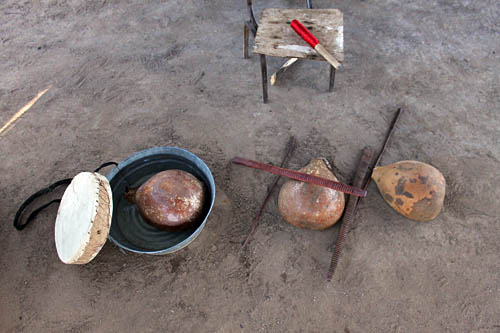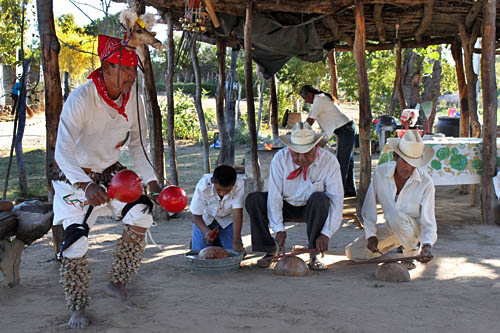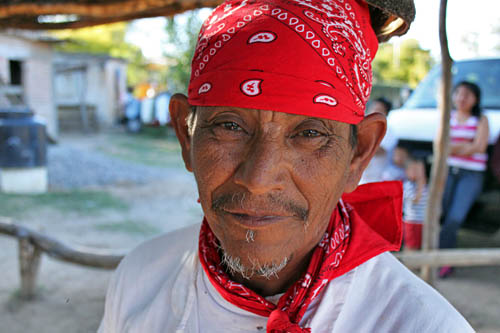I was still oohing and aahing over the town of El Fuerte when the owner of Rio Vista Hotel, Chal Gamez, invited me to join a group bound for a native dance performance by indigenous Mayo Indians. The hotel van jounced along a potholed asphalt road barely wide enough for two vehicles, passing through desolate scrub desert where everything was coated with a thick layer of dun-colored dust. Twenty minutes later we reached the tiny settlement of Capomo, a handful of squat adobe houses in the middle of this vast, desiccated wilderness. We pulled off into a compound in front of one of the houses and sat on simple log benches beneath a canopy constructed of woven twigs.
Chal explained that the Mayo Indians are generally considered to have the purest native blood in Mexico, with most members of the tribe being at least 70% Mayo. Their ancient dances had their origins in animism. The Danza del Venado (Deer Dance), for instance, was performed in a full deerskin outfit with a bow and arrow. However, in 1590 Jesuit missionaries arrived on the scene and began converting the Mayo to Christianity. Rather than prohibiting heathen dances, the crafty Jesuits introduced religion by dance, allowing the natives to intermingle their animistic beliefs with Christian theology. Today these dances are performed at important religious gatherings, such as Semana Santa (Easter week) and the festival of the Virgin of Guadalupe.
Three Mayo males stepped into the enclosure as Chal was completing his explanation and squatted in front of instruments that have not changed for thousands of years. Two of the musicians produced a rhythmic rasping sound by drawing twigs and lengths of notched hardwood over the rounded tops of hollowed-out, halved gourds. A third musician beat a halved gourd floating in a tub of water with a short club, while elders seated on the side played traditional skin covered drums.


When the thumping and rasping merged to create a syncopated rhythm, Jose Luis Talenius shook his bright red gourd rattles and began the Danza del Venado. A small deer’s head was cinched to the top of his head by leather throngs and decorated with flowers, the colors of which vary according to the ritual being performed. Every item of his clothing was symbolic: the red scarf represented blood shed by the deer, white his white shirt and trousers symbolized purity. Each strip of leather on the belt held an individual deer hoof, and the shells wound around his legs represented a rattlesnake entangled with the deer’s body. Lithely, he bounded and pranced around the dusty clearing, stopping here and there to scent the air and twitch nervously. At the end he fell to the ground and quivered; the hunters had sought and won their prey. The Deer Dance was followed by the Judios (Jews) Dance and Pascua (Easter) Dance, each one featuring a different set of intricate steps and symbolism.
Afterward, I asked the dancer if I could take a closeup photo of him and he willingly agreed, proudly declaring, “Tengo setenta anos.” I am seventy years old.

I enjoyed the performance, but was skeptical about the authenticity of the dances until a few days later, when I was sitting in a local restaurant and a commercial for Mexico tourism came on the television. I glanced up just in time to see the very same Jose Luis performing the Danza del Venado on national TV. This guy was the real deal and I was lucky enough not only to see him dance up close, but to speak with him personally.
To be continued…..

Hi Barbara,
Well you will be pleased to know Jose is still dancing today. We had only just arrived Rio Vista in El Fuerte today and barely unpacked and Chal had us in the wagon and off to see Jose do his stuff. Thank you for your posts on the Copper Canyon we will see where the next few days takes us.
Hi Steve: Thanks so much for letting me know. The fact that he is still dancing is quite amazing. If I remember correctly, Jose was in his 80’s when I was there in 2010. Enjoy Copper Canyon. It’s one of the spectacular paces on this earth.
I am always dubious of the “native” dances but it is reassuring to find such an authentic performance. Oh, and I learnt a new word – “jounced” – and it seems so descriptive of a jeep on a rough road. I look forward to more of the ventures of Copper Canyon.
thanks for sharing your mexico escapade.. good cultural immersion!
What incredible posts and photos — and what an incredible trip you’re having. It’s a pleasure to see the world through your eyes.
Great video! Timely for Easter too! Where will you be for Easter?
Hi Sherry: staying in Copper Canyon through Easter (Semana Santa). So much to see & do here. Amazing color against the monotonus, dusty landscape. In Creel now. Yesterday happened upon a Palm Sunday celebration with hundreds of Tarahumara Indians in traditional costume. Breathtaking, & just good fortune.
Thanks, Barbara for the detailed description of the Mayo Indian Danza del Venado. It was interesting to see and hear the various rhythms used in the three dances in your video.
Oh those crafty Jesuits – all over the world Christianity has been spreads by absorbing local customs